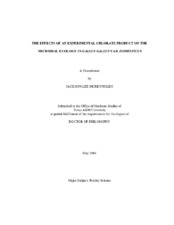| dc.description.abstract | Previous reports have shown that some bacteria utilize a dissimilatory nitrate reductase enzyme (NR) in anaerobic environments. This enzyme reduces nitrate to nitrite and also has been shown to co-metabolize chlorate to cytotoxic chlorite. A commercially available competitive exclusion (CE) product was evaluated for its nitrate reductase activity and therefore its experimental chlorate product (ECP) sensitivity. Of the 29 constituent bacteria of the CE culture, 11 had slight utilization of NR, 3 had moderate utilization of NR; the remaining were NR negative (with slight and moderate utilization: >0.1 to < 1.0 mM and > 1.0 mM nitrate utilized within 6 h, respectively). In vivo studies utilizing CE and ECP showed significant reductions in Salmonella. Although some of the bacteria were affected by ECP, the combined effect of the CE culture and ECP were effective in reducing Salmonella. Clostridium perfringens (CP) is a pathogen in the commercial poultry industry, which is the etiologic agent of necrotic enteritis (NE). Day-of-hatch broilers were fed a wheat diet and assigned to the following groups: control, commercial coccidia vaccine, commercial bursal disease vaccine, or the combination of the two, and challenged with CP in order to develop a disease model. Broilers in each treatment group had significant increases (P≤ 0.05) in lesion scores, mortality, and CP incidence. As pressure mounts for discontinuing the use of antibiotics in the agriculture industry, it is important to develop new strategies to combat these costly enteric pathogens. In vitro investigations evaluated a mixed gut culture with CP and the ECP at 5 mM or a 10 mM concentrations, over time. By 3 h there was a reduction (P≤ 0.05) in the 5 mM ECP and 10 mM ECP treatment groups. In vivo studies showed significant reductions in the incidence of CP and populations of intrinsic E. coli in all of the chickens provided ECP in the drinking water. Birds administered ECP in the feed showed significant reductions in lesion scores, incidence of CP and also had reduced E. coli log10 values. These results show that an ECP could provide the industry with a new management tool for controlling NE. | en |


